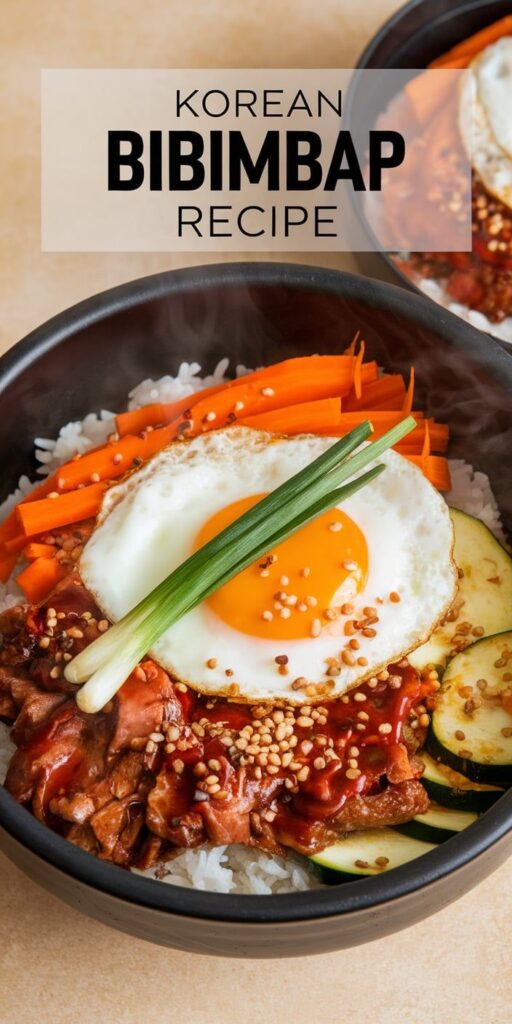Discover the vibrant world of homemade bibimbap, a quintessential healthy Asian dish that brings the heart of Korean cuisine right to your kitchen. This incredible rice bowl recipe transforms simple ingredients into a colorful culinary masterpiece that delights both eyes and taste buds.
Bibimbap represents more than just a meal – it’s a celebration of flavors, textures, and nutritional balance. Each carefully arranged ingredient tells a story of traditional Korean cooking, inviting home chefs to explore a delectable and wholesome dining experience.
From professional kitchens to home cook’s tables, this Korean cuisine favorite offers endless possibilities for customization. Whether you’re a seasoned chef or a curious food enthusiast, bibimbap promises an exciting gastronomic adventure that’s both nourishing and incredibly satisfying.
What is Bibimbap and Its Cultural Significance
Bibimbap stands as a quintessential representation of Korean food history, embodying centuries of culinary tradition and cultural significance. This iconic dish tells a story of Korean cuisine that extends far beyond simple nourishment.
Origins of Traditional Korean Bibimbap
The roots of bibimbap trace back to ancient Korean agricultural practices. Farmers would mix leftover vegetables and rice in a bowl, creating a practical and nutritious meal that reflected the resourcefulness of Korean culinary culture. This humble beginning transformed into a sophisticated dish celebrated worldwide.
Regional Variations Across Korea
Bibimbap variations showcase the diversity of Korean regional cuisines. Different provinces developed unique interpretations of this beloved dish, each reflecting local ingredients and cooking styles.
| Region | Unique Bibimbap Characteristic |
|---|---|
| Jeonju | Considered the birthplace, features premium ingredients |
| Gangwon Province | Includes wild mountain vegetables |
| Jeju Island | Incorporates seafood and unique local produce |
Health Benefits and Nutritional Value
Bibimbap represents one of the most nutritious Korean meals available. Its balanced composition offers multiple health advantages:
- High protein content from meat and eggs
- Rich in vegetables providing essential vitamins
- Whole grains from rice supporting digestive health
- Low-calorie option for weight-conscious individuals
The harmonious blend of ingredients in bibimbap demonstrates the Korean culinary philosophy of creating meals that nourish both body and soul.
Essential Ingredients for Korean Bibimbap Recipe
Crafting an authentic bibimbap begins with selecting the right Korean rice and fresh ingredients. Korean short-grain rice serves as the perfect foundation for this delightful dish, creating a sticky and satisfying base that distinguishes bibimbap from other rice-based meals.

The magic of bibimbap lies in its diverse array of Korean vegetables and proteins. Traditional bibimbap ingredients typically include:
- Spinach
- Bean sprouts
- Carrots
- Shiitake mushrooms
- Zucchini
Protein options range from thinly sliced beef to tofu, with a perfectly fried egg often crowning the dish. The true flavor powerhouse is the gochujang sauce, a spicy red chili paste that transforms the entire meal.
| Ingredient Category | Recommended Options | Preparation Style |
|---|---|---|
| Korean Rice | Short-grain white rice | Steamed |
| Vegetables | Spinach, carrots, bean sprouts | Lightly sautéed |
| Protein | Bulgogi beef, tofu, egg | Grilled or pan-fried |
| Sauce | Gochujang sauce | Mixed or drizzled |
For those seeking vegetarian alternatives, tofu makes an excellent protein replacement. The key is to balance flavors and textures, ensuring each bite delivers a vibrant taste experience characteristic of traditional Korean cuisine.
Step-by-Step Cooking Instructions
Learning how to make bibimbap begins with perfect rice preparation. Start by rinsing short-grain white rice thoroughly, removing excess starch until water runs clear. Cook rice in a rice cooker or pot, ensuring each grain is fluffy and slightly sticky – the foundation of excellent Korean cooking.
For authentic bibimbap recipe instructions, prepare your vegetables separately. Sauté spinach with garlic, julienne carrots into thin strips, and quickly stir-fry bean sprouts with a touch of sesame oil. Each vegetable should retain its vibrant color and crisp texture, creating a colorful presentation typical of traditional Korean food.
Marinate thin slices of beef (sirloin works best) in a mixture of soy sauce, garlic, and sesame oil for maximum flavor. Quickly sear the meat in a hot skillet, cooking just until it’s slightly caramelized but still tender. This protein will be a key component of your bibimbap bowl.
The final step in cooking Korean food involves assembling your bibimbap. Place steamed rice at the bottom of a stone or ceramic bowl, artfully arrange your cooked vegetables and meat on top, and crown with a sunny-side-up egg. Drizzle gochujang (Korean red pepper paste) over everything for that signature spicy kick that makes bibimbap truly irresistible.





